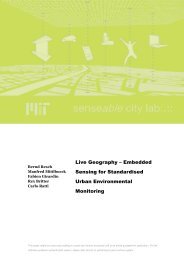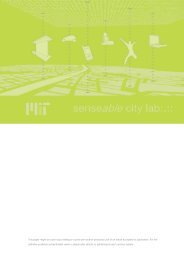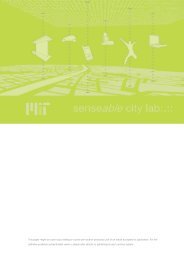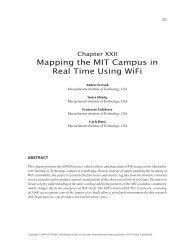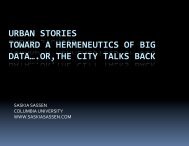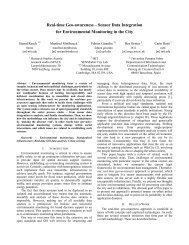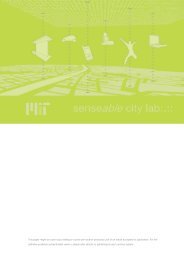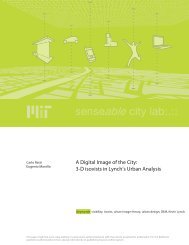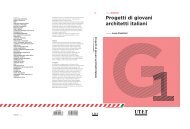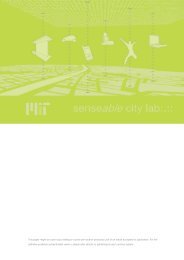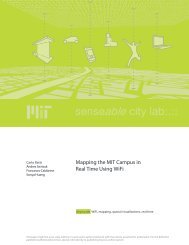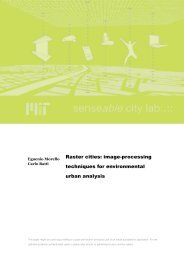A review of the characteristics of nanoparticles in the urban ...
A review of the characteristics of nanoparticles in the urban ...
A review of the characteristics of nanoparticles in the urban ...
Create successful ePaper yourself
Turn your PDF publications into a flip-book with our unique Google optimized e-Paper software.
10<br />
P. Kumar et al. / Atmospheric Environment xxx (2010) 1e18<br />
development and evaluation has been limited by <strong>in</strong>sufficient<br />
measurements <strong>of</strong> number and size distributions (see Section 4) and<br />
lack <strong>of</strong> detailed <strong>in</strong>formation on emission factors. Information on<br />
particle number emission factors (as dist<strong>in</strong>ct from mass) for <strong>in</strong>dividual<br />
types <strong>of</strong> vehicles under a range <strong>of</strong> driv<strong>in</strong>g conditions is not<br />
abundantly available for rout<strong>in</strong>e applications. Studies <strong>of</strong> particle<br />
number emission factors show up to an order <strong>of</strong> magnitude<br />
difference for a given vehicle type under near-identical conditions<br />
(Jones and Harrison, 2006; Keogh et al., 2010; Kumar et al., 2008b).<br />
Such uncerta<strong>in</strong>ty will generally affect <strong>the</strong> predictions <strong>of</strong> any model<br />
to a similar degree. Model <strong>in</strong>ter-comparison studies have been<br />
carried out for ‘conventional’ vehicle emissions (e.g. see Lohmeyer<br />
et al., 2002) but not for particle number concentration prediction.<br />
Currently, <strong>the</strong>re are several particle dispersion models available<br />
that <strong>in</strong>clude particle dynamics e.g. MAT (Ketzel and Berkowicz,<br />
2005) which uses a multi-plume scheme for vertical dispersion<br />
and rout<strong>in</strong>es <strong>of</strong> <strong>the</strong> aerodynamics model AERO3 (Vignati, 1999),<br />
MATCH (Gidhagen et al., 2005) which is an Eulerian grid-po<strong>in</strong>t<br />
model and <strong>in</strong>cludes aerosol dynamics, MONO32 (Pohjola et al.,<br />
2003) and AEROFOR2 (Pirjola and Kulmala, 2001) e both <strong>in</strong>clude<br />
gas-phase chemistry and aerosol dynamical processes. Some<br />
operational models disregard particle dynamics e.g. OSPM<br />
(Berkowicz, 2000) which uses a comb<strong>in</strong>ation <strong>of</strong> a plume model for<br />
<strong>the</strong> direct contribution and a box model for <strong>the</strong> re-circulat<strong>in</strong>g<br />
pollution part <strong>in</strong> <strong>the</strong> street canyon; several o<strong>the</strong>rs are described <strong>in</strong><br />
Holmes and Morawska (2006). Performance evaluation <strong>of</strong> such<br />
particle number concentration models aga<strong>in</strong>st validation data is<br />
essential if <strong>the</strong>y are to be used for develop<strong>in</strong>g mitigation policies.<br />
5.1. Importance <strong>of</strong> transformation and loss processes<br />
<strong>in</strong> dispersion models<br />
Table 6 summarises <strong>the</strong> effect <strong>of</strong> transformation and loss<br />
processes on particle number concentrations. A simple qualitative<br />
description <strong>of</strong> <strong>the</strong> nature <strong>of</strong> any change is <strong>in</strong>cluded. Coagulation acts<br />
to reduce <strong>the</strong> number <strong>of</strong> particles <strong>in</strong> <strong>the</strong> atmosphere (H<strong>in</strong>ds, 1999).<br />
Gidhagen et al. (2005) used a three dimensional Eulerian grid-po<strong>in</strong>t<br />
model for calculat<strong>in</strong>g distributions <strong>of</strong> particle number concentrations<br />
over Stockholm. They found <strong>the</strong> overall loss to be up to 10%<br />
due to coagulation when compared with <strong>in</strong>ert particles. Ketzel and<br />
Berkowicz (2005) observed a similar effect (up to 10% loss) by<br />
coagulation <strong>in</strong> Copenhagen. However, o<strong>the</strong>r studies found <strong>the</strong><br />
effect <strong>of</strong> coagulation too slow to affect number concentrations <strong>in</strong><br />
ei<strong>the</strong>r a car exhaust plume or under typical <strong>urban</strong> conditions<br />
(Pohjola et al., 2003; Zhang and Wexler, 2002).<br />
Nucleation and dilution promote <strong>the</strong> formation <strong>of</strong> new<br />
particles that may <strong>of</strong>fset <strong>the</strong> loss mechanisms. For <strong>in</strong>stance,<br />
Table 6<br />
Transformation and loss processes that modify particle number concentrations <strong>in</strong><br />
<strong>the</strong> atmosphere (Ketzel and Berkowicz, 2004).<br />
Process Sources/S<strong>in</strong>ks Change <strong>in</strong> number<br />
concentrations<br />
Coagulation Collision <strong>of</strong> particles with each o<strong>the</strong>r loss<br />
Condensation Aggregation <strong>of</strong> gaseous phase<br />
none<br />
species onto particle surfaces<br />
Dilution and/or Depend<strong>in</strong>g on <strong>the</strong> concentration <strong>in</strong> ga<strong>in</strong> or loss<br />
mix<strong>in</strong>g <strong>the</strong> dilut<strong>in</strong>g air mass<br />
Dry deposition Removal <strong>of</strong> particles through<br />
loss<br />
surface contact<br />
Evaporation Initially reduction <strong>in</strong> particle size none or loss<br />
that leads to complete loss or a<br />
residual solid core<br />
Nucleation Formation <strong>of</strong> new particles through<br />
gas-to-particle conversion or<br />
photochemical nucleation<br />
ga<strong>in</strong><br />
pseudo-simultaneous measurements <strong>in</strong> a Cambridge street canyon<br />
<strong>in</strong>dicated about a five times greater formation rate <strong>of</strong> new particles<br />
at ro<strong>of</strong>top level than at street level (Kumar et al., 2009a), attributed<br />
to less efficient scaveng<strong>in</strong>g mechanisms (Kerm<strong>in</strong>en et al., 2001) and<br />
favourable conditions for gas-to-particle conversion (Kulmala et al.,<br />
2000) at ro<strong>of</strong>top. O<strong>the</strong>r processes such as condensation and evaporation<br />
have negligible effects (Zhang et al., 2004).<br />
Dry deposition occurs when a particle is removed at an aire<br />
surface <strong>in</strong>terface as a result <strong>of</strong> particle Brownian diffusion. This can<br />
remove <strong>the</strong> smaller particles (i.e. nucleation mode) more efficiently<br />
due to <strong>the</strong>ir higher diffusion coefficient compared with that for<br />
large particles (i.e. accumulation mode). The deposition velocity<br />
will be relatively high for small particles and for high friction<br />
velocities (H<strong>in</strong>ds, 1999). For example, Kumar et al. (2008c) estimated<br />
dry deposition losses <strong>of</strong> vehicle emitted particles onto a road<br />
surface <strong>in</strong> a Cambridge street canyon. The relative removal <strong>of</strong> total<br />
particle number concentrations <strong>in</strong> <strong>the</strong> 10e30 nm range was estimated<br />
to be about 19% larger than <strong>the</strong> particles <strong>in</strong> <strong>the</strong> 30e300 nm<br />
range at <strong>the</strong> road surface compared to concentrations at 1 m above<br />
<strong>the</strong> road level. Likewise, city scale model calculations <strong>in</strong> Stockholm<br />
by Gidhagen et al. (2005) found up to 25% loss <strong>of</strong> total particle<br />
number concentrations <strong>in</strong> about 3e400 nm size range at certa<strong>in</strong><br />
locations, and up to 50% <strong>in</strong> episodic conditions. Dry deposition is<br />
<strong>the</strong>refore an important loss process that can reduce total particle<br />
number concentrations considerably. The effect <strong>of</strong> dry deposition at<br />
various spatial scales should be treated appropriately <strong>in</strong> particle<br />
dispersion models.<br />
Current knowledge is <strong>in</strong>sufficient to describe behaviour <strong>of</strong> transformation<br />
processes at different spatial scales <strong>in</strong> any detail. Therefore<br />
<strong>the</strong> above figures may vary <strong>in</strong> different sett<strong>in</strong>gs; e.g. <strong>in</strong> vehicle-wakes<br />
(Kumar et al., 2009c; M<strong>in</strong>oura et al., 2009), street canyons (Kumar<br />
et al., 2009a; Pohjola et al., 2003), <strong>urban</strong> areas (Wehner et al.,<br />
2002) or globally (Raes et al., 2000). The comb<strong>in</strong>ed effect <strong>of</strong> particle<br />
transformation processes may also vary with sett<strong>in</strong>g and scale<br />
depend<strong>in</strong>g on meteorological conditions, source terms and <strong>the</strong><br />
background concentrations <strong>of</strong> particles and gas phase species.<br />
Does performance <strong>of</strong> dispersion models suffer if particle dynamics<br />
are disregarded? Particle dynamics can probably be neglected for<br />
street scale modell<strong>in</strong>g (Ketzel and Berkowicz, 2004; Kumar et al.,<br />
2008c); e.g. as <strong>in</strong> exist<strong>in</strong>g dispersion models such as OSPM. Recent<br />
work by Kumar et al. (2009b) supports this conclusion. Particle<br />
dynamics were disregarded and particle number concentrations<br />
predicted by us<strong>in</strong>g a modified Box model (Kumar et al., 2009b), OSPM<br />
(Berkowicz, 2000), and <strong>the</strong> CFD code FLUENT (Solazzo et al., 2008).<br />
Particle number concentrations predicted by all three models were<br />
with<strong>in</strong> a factor <strong>of</strong> three <strong>of</strong> <strong>the</strong> measured values. However, a number <strong>of</strong><br />
studies <strong>in</strong>dicate that particle dynamics should be <strong>in</strong>cluded <strong>in</strong> city<br />
scale models where <strong>the</strong>y may affect <strong>the</strong> total number concentrations<br />
considerably (Gidhagen et al., 2005; Ketzel and Berkowicz, 2004;<br />
Ketzel et al., 2003; Kumar et al., 2009a). Changes <strong>in</strong> total particle<br />
number concentrations due to <strong>the</strong> comb<strong>in</strong>ed effects <strong>of</strong> transformation<br />
and loss processes can lie between a loss <strong>of</strong> 13 and 23%<br />
compared to an <strong>in</strong>ert treatment (Ketzel and Berkowicz, 2005).<br />
The above observations highlight a number <strong>of</strong> challenges associated<br />
with dispersion modell<strong>in</strong>g <strong>of</strong> particle number concentrations<br />
and <strong>the</strong> role <strong>of</strong> particle dynamics at various spatial scales. Extensive<br />
measurements <strong>of</strong> nanoparticle concentrations would be helpful <strong>in</strong><br />
evaluat<strong>in</strong>g dispersion model performance and hence support<strong>in</strong>g <strong>the</strong><br />
modell<strong>in</strong>g that is required for <strong>the</strong> evaluation <strong>of</strong> mitigation policies.<br />
6. Effect <strong>of</strong> <strong>nanoparticles</strong> on health and <strong>the</strong> environment<br />
This section summarises recent advances concern<strong>in</strong>g <strong>the</strong> impact<br />
<strong>of</strong> atmospheric <strong>nanoparticles</strong> on human health and <strong>urban</strong> visibility<br />
and highlights some rema<strong>in</strong><strong>in</strong>g research requirements.<br />
Please cite this article <strong>in</strong> press as: Kumar, P., et al., A <strong>review</strong> <strong>of</strong> <strong>the</strong> <strong>characteristics</strong> <strong>of</strong> <strong>nanoparticles</strong> <strong>in</strong> <strong>the</strong> <strong>urban</strong> atmosphere and <strong>the</strong>..., Atmospheric<br />
Environment (2010), doi:10.1016/j.atmosenv.2010.08.016



